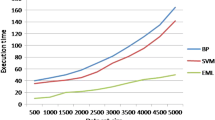Abstract
Interval-valued data offer a valuable way of representing the available information in complex problems where uncertainty, inaccuracy or variability must be taken into account. In addition, the combination of Interval Analysis with soft-computing methods, such as neural networks, have shown their potential to satisfy the requirements of the decision support systems when tackling complex situations. This paper proposes and analyzes a new model of Multilayer Perceptron based on interval arithmetic that facilitates handling input and output interval data, but where weights and biases are single-valued and not interval-valued. Two applications are considered. The first one shows an interval-valued function approximation model and the second one evaluates the prediction intervals of crisp models fed with interval-valued input data. The approximation capabilities of the proposed model are illustrated by means of its application to the forecasting of daily electricity price intervals. Finally, further research issues are discussed.
Similar content being viewed by others
Abbreviations
- iMLP:
-
interval Multilayer Perceptron
- INN:
-
Interval Neural Network
- MAPE:
-
Mean Absolute Percentage Error
- MLP:
-
Multilayer Perceptron
References
Smith K.A. (2005) Applications of neural networks. Comp. Oper. Res. 32(10): 2495–2497
Smith K.A., Gupta J.N.D. (2000) Neural networks in business: techniques and applications for the operations researcher. Comp. Oper. Res. 27(11–12): 1023–1044
Wong B.K., Lai V.S., Lam J. (2000) A bibliography of neural networks business applications research: 1994–1998. Comp. Oper. Res. 27(11–12): 1045–1076
Perez M. (2006) Artificial neural networks and bankruptcy forecasting: A state of the art. Neural Comput. Appl. 15(2): 154–163
Zhang G., Patuwo B.E., Hu M.Y. (1998) Forecasting with artificial neural networks: The state of the art. Int. J. Forecast. 14(1): 35–62
Zhang G.P. (2001) An investigation of neural networks for linear time-series forecasting. Computers and Operations Research 28(12): 1183–1202
Craven M.W., Shavlik J.W. (1997) Using neural networks for data mining. Future Gener. Comp. Syst. 13(2–3): 211–229
Pal S.K., Talwar V., Mitra P. (2002) Web mining in soft computing framework: relevance, state of the art and future directions. IEEE Trans. on Neural Networks 13(5):1163–1177
Bishop C.M. (1995) Neural Networks for Pattern Recognition. Oxford University Press, Oxford
Fine T.L. (1999) Feedforward Neural Network Methodology. Springer-Verlag, New York
Ward M., Peng W., Wang X. (2004) Hierarchical visual data mining for large-scale data. Computational Statistics 19: 147–158
Bock H.H., Diday E.(eds) (2000) Analysis of Symbolic Data: Exploratory Methods for Extracting Statistical Information from Complex Data. Springer-Verlag, Berlin
Billard L., Diday E. (2003) From the statistics of data to the statistics of knowledge: symbolic data analysis. J. Am. Stat. Asso. 98(462): 470–487
Moore R.E. (1966) Interval Analysis. Prentice-Hall, Englewood Cliffs, NJ
Kearfott B. (1996) Interval computations: Introduction, uses, and resources. Euromath Bull. 2(1): 95–112
Young R.C. (1931) The algebra of many-valued quantities. Mathematische Annalen 104: 260–290
Beheshti, M., Berrached, R., de Korvin, A., Hu, C. and Sirisaengtaksin,O.: On interval weighted three-layer neural networks. In: Proceedings of the 31st Annual Simulation Symposium, pp. 188–195, Boston, MA, USA, 1998.
Ishibuchi H., Tanaka H., Okada H. (1993) An architecture of neural networks with interval weights and its application to fuzzy regression analysis. Fuzzy Sets Syst. 57: 27–39
Baker M.R., Patil R. (1998) Universal approximation theorem for interval neural networks, Reliab. Comput. 4:235–239
Simoff, S. J.: Handling uncertainty in neural networks: An interval approach. In: Proceedings of IEEE International Conference on Neural Networks, pp. 606–610, Washington, DC, USA, 1996.
Drago G.P., Ridella S. (1999) Possibility and necessity pattern classification using an interval arithmetic perceptron. Neural Comput. Appl. 8(1):40–52
Rossi, F. and Conan-Guez, B.: Multilayer perceptron on interval data. In: K. Jajuga, A. Sokolowski and H. H. Bock (eds.), Classification, Clustering, and Data Analysis (IFCS 2002), pp. 427–434, Cracow, Poland, 2002.
Patiño-Escarcina, R., Callejas Bedregal, B. and Lyra, A.: Interval computing in neural networks: One layer interval neural networks. In: G. Das and V. P. Gulati (eds.), Proceedings of the 7th International Conference on Information Technology, CIT 2004, pp. 68–75, Hyderabad, India, 2004.
Rumelhart, D. E., Hinton, G. E. and Williams, R. J.: Learning internal representations by error propagation. In: D. E. Rumelhart and J. M. McClelland (eds.), Parallel distributed processing: explorations in the microstructure of cognition, vol. 1: foundations, pp. 318–362, MIT Press: Cambridge, MA, USA, 1986.
Girosi F., Jones M., Poggio T. (1995) Regularization theory and neural networks architectures. Neural Comput. 7(2): 219–269
Luenberger D.G. (1984) Linear and Nonlinear Programming. Reading, MA, Addison-Wesley
Bunn D.W. (ed) (2004) Modelling Prices in Competitive Electricity Markets. John Wiley & Sons, Chichester, UK
Mateo González A., Muñoz San Roque A., García González J. (2005) Modeling and forecasting electricity prices with input/output hidden Markov models. IEEE Trans. on Power Syst. 20(1): 13–24
Author information
Authors and Affiliations
Corresponding author
Additional information
Research funded by Universidad Pontificia Comillas.
Rights and permissions
About this article
Cite this article
Roque, A.M.S., Maté, C., Arroyo, J. et al. iMLP: Applying Multi-Layer Perceptrons to Interval-Valued Data. Neural Process Lett 25, 157–169 (2007). https://doi.org/10.1007/s11063-007-9035-z
Received:
Accepted:
Published:
Issue Date:
DOI: https://doi.org/10.1007/s11063-007-9035-z




